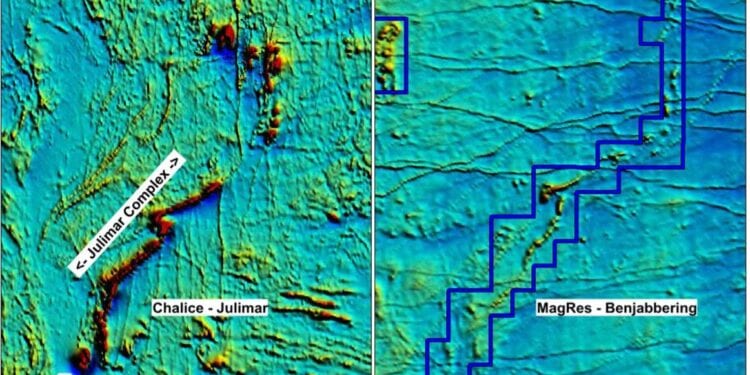Hunting Nickel And PGEs In Highly Sought After WA Area
Magnetic Resources (ASX:MAU) is the latest explorer looking to test the exciting potential of Julimar-like areas in Western Australia.
The company has begun exploration work at four separate projects totalling 322sq.km including Benjabbering E70/5537, Trayning E70/5534, Goddard E70/5538 and Korrelocking ELA70/5771, which are all held 100% by Magnetic Resources.
Managing Director, George Sakalidis, said the licences are located from 90km out to 150km northeast of Chalice Gold Mines Limited’s exciting Julimar Ni-Pd Discovery.
These projects were selected based on aeromagnetic interpretation after noting the structural setting of the Julimar complex and the Gonneville mineralised discrete magnetic mineralised Ni-Cu-PGE rich intrusion.
The Julimar discovery in March 2020 has led to a massive pegging rush covering 30,000 sq. km. The Julimar Intrusive Complex flags the existence of a new and unexplored West Yilgarn Ni-Cu-PGE Province along the western margin of the Archean Yilgarn Craton.
Benjabbering E70/5537
The 111sq. km Benjabbering Project has a large 25km long sinuous aeromagnetic pattern that trends in a NE and N direction and is very similar to the Julimar trends and structures.
Several thickened zones have been Identified which represent possible feeder areas for potential Ni-Cu-PGE mineralisation. These target areas will be followed up in the field with initial roadside drilling and subsequent more detailed AC drilling after access agreements with landowners are finalised.
The geology at Julimar comprises a 26km-long layered mafic-ultramafic sill which at its southern end (Gonneville) dips at 45°W with a flat northerly plunge. The main host at Gonneville is serpentinite, with only limited gabbro evident on the drill sections. Although the new Hartog area is to the north of the Gonneville magnetic intrusion and is expected to have less magnetic mafic rocks associated.
The bedrock geology at Benjabbering is mapped as comprising a series of granitic rocks ranging including biotite granite, and granodiorite plus more metamorphosed rocks such as banded and tonalitic gneiss. However, bedrock outcrops are sparse, most of the area being covered with Quaternary eolian, alluvial and colluvial deposits overlying Tertiary sand and rare laterite. The sinuous aeromagnetics is interpreted to be caused by a mafic unit under cover.
Trayning E70/5534
The 68sq. km Trayning tenement covers a broad series of NE-trending magnetic zones, which are crosscutting the NS Archean fabric further to the east. In several locations there are linear features containing distinctive magnetic highs up to 2km in length representing possible ultramafic feeder zones prospective for Ni-Pd, where access is being sought for shallow drilling.
Most of the tenement is covered by Tertiary sandplain with rare pisolitic laterite remnants which in places is overlain by Quaternary colluvium.
Goddard E70/5538
The 70sq. km Goddard tenement contains a pronounced inverted U-shaped magnetic zone in the eastern part of the tenement, which could be a possible fold structure. Several circled areas will be initially tested with roadside drilling followed with more drilling after access agreements are finalized.
A series of circular Quaternary salt pans comprising lacustrine deposits of sand and clay occupies the central part of the tenement, associated with Lake Koombekine situated on the western margin of the licence. Very limited outcrops of granitic rocks occur, ranging from biotite granite to migmatite. The remainder of the tenement is covered with Quaternary colluvium and alluvium overlying Tertiary sand deposits.
Korrelocking E70/5771
The 73sq.km Korrelocking tenement covers a pronounced 2km-long E-W trending magnetic anomaly, which may represent an ultramafic feeder zone prospective for NI-Pd. There are also numerous localized EW dykes located here. This 2km EW target may be exploiting reactivated older structures which may have influenced or controlled the intrusion of Julimar-type mafic-ultramafic bodies. Thus, there may be a structural relationship between some Proterozoic dykes and Julimar- type intrusions. This area is well traversed by roads and initial AC drilling is recommended over the road verges that are along the 2km long EW magnetic anomaly, which is under cover. The bedrock is mapped as scattered outcrops of adamellite and biotite granite overlain by Tertiary sandplain with isolated patches of lateritic gravel in turn overlain by Quaternary silt, sand and gravel derived from underlying and adjacent laterite and bedrock.
“With this amazing 30,000 sq.km pegging rush for Julimar tyle Ni-Cu-PGE mafic-ultramafic complexes, Magnetic has picked up 322 sq km of ground with some excellent targets,” Mr Sakalidis said.
“The Benjabbering Project has a very large 30km sinuous aeromagnetic target that has similar shape and structure as the Julimar intrusive and has never been drill tested.
“Numerous discrete large-scale targets identified over Magnetic’s three granted projects will be initially drill tested along road traverses followed by more extensive drilling when access agreements are finalised with local landowners.
“Magnetic’s HN9 and Lady Julie Projects remain the company’s primary focus after 20,000m of drilling has been completed in the last 3 months with assay results pending.”
More From Magnetic Resources
Magnetic Resources NL Completes A$12M Placement for Lady Julie Gold Project
Magnetic Resources NL (ASX: MAU) has announced the successful completion of its A$12M single tranche placement to sophisticated, professional, and...
Read more
















